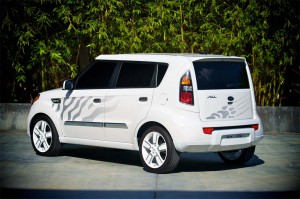Henry Ford liked to tell his customers they could order a Model T in any color they wanted “as long as it’s black.” That certainly wouldn’t fly today, the automotive world awash in bright hues that cover the spectrum for pearlescent purple to flaming red.
But while a maker like Bentley might offer as many as 20 different shades – and even permit buyers to opt for additional custom colors – the reality is that the vast majority of buyers opt for only a handful of hues. And white was the top pick for American motorists during the 2011 model-year.
At 21%, white not only rolled into the top spot but displaced the perennial favorite, silver, which slipped just a micron behind black, which proved a favorite with one in five U.S. motorists, according to top-tier paint supplier PPG.
With white, black and silver all coming in at over 20%, the rest of the spectrum had to pick up the scraps. Gray – which also includes similar hues like pewter – was the choice of 13% of buyers. The other shades fell below 10%, starting with red, at 9%, blue at 8%, “natural” shades, like beige, at 6%, and all others garnered a minimal 2% combined.
That’s ironic, as a PPG survey finds that 40% of buyers say they’d like a wider choice of colors – despite the addition of such edgy hues as the Lime Squeeze Green offered on the Ford Fiesta and the various shades of flaming orange and yellows that a number of makers have been offering in recent years.
The study found 77% saying that exterior color is an important factor when they buy a car, and 31% of buyers claimed they’d be willing to pay more for a shade that “expresses their personality.”
Apparently most folks have a rather somber temperament if the 2011 color choices are any indication.
Why has white surged to the top? It’s a traditional favorite in some markets, notably Japan and India, where it is seen as a sign of purity. But a PPG planner suggested it may have gained traction since it is the color of choice with some high-tech devices, such as the Apple iPhone.
Color choices also vary from one region to another, notes Bob Carter, general manager of Toyota. “New Yorkers can’t get enough cars in black-on-black. But ship that same car to Phoenix, and you could barely give it away.”
Even the economy has an influence, historical trends reveal. Bright shades pick up in popularity during boom years, dark tones when times are tough. Color choices also flow with fashion trends, and what’s popular on the runways of Paris this season may directly influence what’s in showrooms next autumn.
Automotive design trends are also a factor. Some shades work wonderfully on soft shapes, such as the original Ford Taurus. But they may seem horrible on an angular vehicle, like Cadillac’s edgy CTS sedan. So manufacturers are increasingly aware of how the catalogue of colors they offer will match each product’s shape.
Today’s colors are a lot more distinctive than those of even a few decades ago. Henry Ford would have to spell out precisely which black he wanted, for one thing, with suppliers offering the basic shade, a sparkling black or even a hue subtly tinted green.
In all, PPG says it is offering 40 different new hues for automotive planners to pick from — including Grape Spritz. Only a handful of those will actually make it into the paint booth by the 2014-2015 timeframe.

